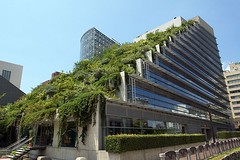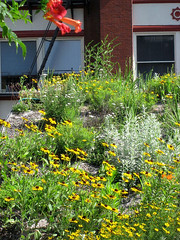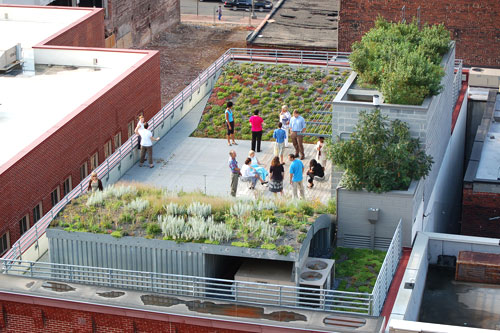Instead of building new green places, let’s green the ones we have

Posted January 26, 2010 at 1:32PM
Vanessa Keith has written an outstanding post on the greening of urban buildings and neighborhoods, on the blog Urban Omnibus, a project of the Architectural League of New York. She begins by noting that “tabula rasa eco-cities trumpeting their green credentials and high levels of environmental sustainability” are being built or proposed across the globe (see, for example, near the end of this post), and queries: “one might ask, with all the urban fabric which currently exists, why build at all, and most especially on such a massive scale?” Instead, Keith suggests that we add green features to the places we already have.
“one might ask, with all the urban fabric which currently exists, why build at all, and most especially on such a massive scale?” Instead, Keith suggests that we add green features to the places we already have.
I couldn’t agree more. Particularly given that so many US cities have underutilized infrastructure left from the days of urban flight, and given that central city neighborhoods have the lowest per capita environmental footprint, paving over farmland, forests or desert to accommodate the latest green technology just doesn’t make sense.
In fact, one can even make the argument (and some do) that one doesn’t need green features in the city, since the city is inherently green. I would certainly agree that, at least in terms of regulation, greater burdens should be placed on new suburban developments. But I also think all development should contribute to environmental health and, besides, many of the techniques we might apply to green city neighborhoods produce multiple benefits for livability, making cities all the more appealing.
And that brings me to Keith’s main point, which is that we can make our urban building stock more environmentally friendly by reforestation and other vegetation, along with green technology:
“How might all this begin to be implemented? [Above] you see a piece of New York City to which we have applied some of the technologies . . . Large scale urban farming which takes place indoors and on large expanses of roof, greenscreens to let plants to climb the vertical surfaces of the city, trees which are now able to grow on the city roofscape. Roof ponds and artificial waterfalls for cooling and electrical generation. Solar and wind devices which form sculptural elements in the city, performing a function as well as having an aesthetic. Ports for plug-in electric vehicles which gather energy from photovoltaics. Solar panels incorporated into street poles, and vertical wind turbines which form a rhythm in the streetscape. Bicycle lanes, room for walking and the incorporation of still more trees.”
Cool stuff, in some cases literally. Read the entire, well-illustrated commentary here.
Speaking of green roofs, you are unlikely to encounter any greener than the one I recently had the pleasure of touring, on top of the DC headquarters of the American Society of Landscape Architects and pictured just above. The fact sheet on the roof, intended as a demonstration project, says that the design includes two elevated “waves” that create a pleasant foliage-enclosed space and block the unsightly view of the rooftop HVAC systems. One of the waves is planted primarily with sedums; the other, with slightly deeper soil, is planted with drought-resistant perennials and grasses as well as sedums.
Innovative use of aluminum grating allows visitors to walk over the roof’s plant material without damaging it and also allows access to the roof structure for maintenance. The designers made maximum use of the structural capacity of the building, varying soil depths and plantings to take advantage of differing load capacities. For example, the elevator shaft has the greatest structural capacity and could accommodate 21 inches of soil; plantings on the elevator shaft include sumac trees, which may grow as tall as 30 feet at maturity.
Data collection from the roof indicates that it absorbed more than three-quarters of rainfall during its first year, significantly reducing the amount of nitrogen and other pollutants compared to street runoff. Temperatures on the ASLA roof have been as much as 32 degrees lower than on conventional black roofs on nearby buildings. Read all about it and view neat photos on ASLA’s web site, and here’s a short video:
Video tour of ASLA's Green Roof in Washington, DC from ASLA on Vimeo.


